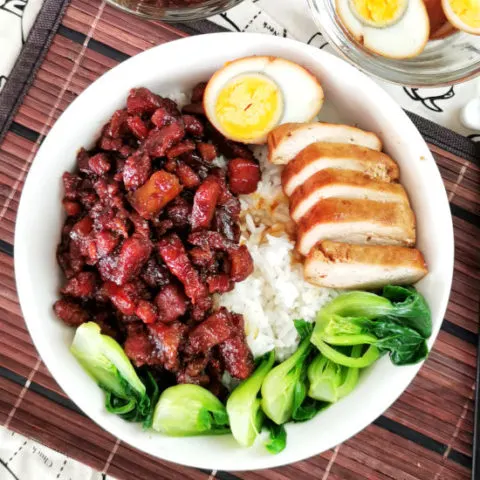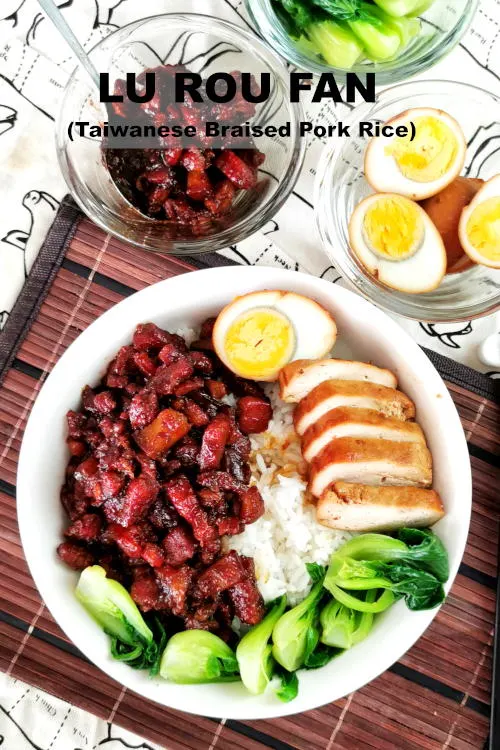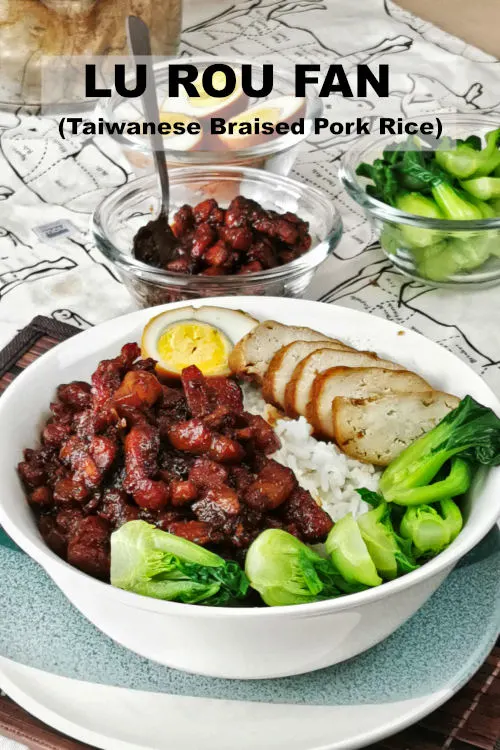Lu Rou Fan is braised pork belly with soy sauce, hard-boiled egg, tofu, and some vegetables served on steamed rice. It is the transliteration of 滷肉飯 in Chinese, with the approximate pronunciation. The three words 滷肉飯 in Chinese mean braise, meat, and rice, respectively. You can get this street food in most Taiwanese restaurants, and it is one of the most well-known street foods in Taiwan and abroad.
When I took a bite of this tender pork enrobed in a glossy, thick, shiny sauce, I couldn’t resist gobbling down the whole bowl of Lu Rou Fan in no time.
I was not expecting much initially, as the color and look were not impressive, but soon I knew judging it from the fine dining perspective was utterly wrong and undermined this street food. The flavor is out of the world.
I want to show you how I make Lu Rou Fan, the Taiwanese braised pork rice, in this recipe.
Note: This post may contain affiliate links. Please read my privacy policy for more info. I may receive commissions for purchases made through links in this post. As an Amazon Associate, I earn from qualifying purchases.
1. Prepare the key ingredients
Below is the summary of the key ingredients required to make this Taiwanese street food.
a. Use pork belly for the best result
Pork is the primary ingredient for Lu Rou Fan, but not all cuts will deliver the same result. Pork belly is the choice as it has a fair share of fat, which tenderizes the meat.
Those who crave Lu Rou Fan will tell you it has to be pork with fat, primarily pork belly with skin. The skin will release a gelatin-like substance during braising and thicken the gravy, forming a lustrous, glossy sheen on the meat.
Let’s prepare the pork:
- Get ready for half a kg of pork belly, preferably with skin.
- Some pork might have an unwanted porky smell. If it happens, place the pork belly in a pot of cold water and bring it to a boil. When the water is boiling, remove the pork and clean it under running water.
- If you find the skin is not clean, scrape the skin with the knife to remove any hair or dirt that may still be there. Wash again.
- Cut the pork belly into small chunks, preferably within half to one cm thick, then cut into small pieces.
b. Make some hard-boiled eggs
Making hard-boiled eggs is easy but can be frustrating if you find the egg membrane and shell hard to peel off. The eggs will have multiple chips and marks instead of a shiny and smooth surface. Instead, try the following method if you have difficulty making a perfect hard-boiled egg. I have used this even for soft eggs (those that are only boiled for seven minutes for ramen, in which the yolk is still jiggling) and to be able to peel it effortlessly.
How to peel hard-boiled eggs easily
- Bring a pot of water to a boil.
- Place the egg into the water carefully. You can use chilled eggs from the refrigerator if you want the egg yolk to remain runny while the egg white has already set.
- Let it boil undisturbed for seven minutes for a soft ramen egg or up to sixteen minutes to cook it thoroughly.
- Remove the eggs, plunge them into ice water, and chill in the refrigerator.
- Remove the chilled eggs, then crack them while still wet. The eggshell will detach from the egg easily.
c. Use Firm tofu
Firm tofu is a welcome addition to the eggs and pork, absorbing the flavor like a sponge. However, soft tofu is unsuitable as it will easily break while braising. Braising the whole tofu prevents it from absorbing too much braising liquid. It also prevents sliced tofu from breaking while cooking.
d. Seasoning and aromatics for making Lu Rou Fan
- The main seasoning for the pork is the soy sauce called 酱油, which is for braising. This soy sauce is slightly thicker and darker than light soy sauce, which is suitable for braising or stewing. You can substitute it with a combination of light and dark soy sauce as the substitute.
- Other ingredients include a combination of garlic, shallot, and green onions. While garlic and green onions are added to the pork, you must deep-fry the shallots to get the best result.
- There are ready-made fried shallots sold in the Asian grocery store, which is convenient. However, frying it with the oil rendered from the pork is pretty easy. All you need is to slice the shallot thinly and fry until golden. Please follow the steps in the recipe for the details.
- Another essential ingredient for making Lu Rou Fan is Chinese five-spice powder. Generally, it contains star anise, cloves, cinnamon sticks, Sichuan peppercorns, and fennel seeds. However, it can differ from brand to brand.
2. Steps to make Lu Rou Fan
Here are the detailed steps for making Lu Rou Fan, assuming you have prepared and cut all the ingredients.
a. Fry the pork
- Place the pork belly pieces in a heated wok or pan. Adding oil is unnecessary as the pork fat will eventually render and become non-stick.
- Stir-fry the pork over medium heat and constantly stir to ensure even cooking. The pork will release its moisture initially, making the pan slightly wet. However, as you continue stir-frying the pork, the liquid will eventually evaporate, and only the oil remains. The color of the pork will also start to change.
- Once you notice oil rendered from the pork, push the pork to one side of the pan and tilt the pan slightly to allow the oil to gather on the other side. Add the thinly sliced shallot to the oil and let it deep-fry over low heat. The shallot will lose its moisture and turn to a beautiful light golden color. It may take a few minutes to achieve this color. If your pan is too small, remove the pork and leave the lard inside the pan to fry the shallot.
- Now add some brown sugar to the pork. Brown sugar is more suitable than white sugar as it caramelizes quickly, forming a slightly sticky brownish layer on the pork. This step helps to add color to the pork. Besides brown sugar, rock sugar is another alternative commonly used in this Lu Rou Fan recipe.
- Include the green onions and garlic once the sugar is caramelized. Garlic is not added earlier to avoid getting burned and turning bitter.
- Once the garlic has become aromatic, add the soy sauce 酱油 (or a mix of light and dark soy sauce.) I added slightly less than the intended amount to have the option to make the final adjustment when it is nearly done. Soy sauce darkens the color of the pork, which starts to resemble those served in the restaurant.
b. Braise the pork
- Season with some salt, ground white pepper, and five-spice powder.
- Add the peeled, hard-boiled eggs and firm tofu.
- Fill the pan with sufficient water to submerge all the ingredients. If the pan is too large, you may want to transfer the pork to a smaller pot. Bring it to a boil, then reduce the heat to cook it at a barely simmering temperature, with tiny burps of bubbles popping up randomly.
- Braise the pork, egg, and tofu low and slow for at least 1.5 hours or until the pork is tender. Stir occasionally to ensure all the ingredients are cooked evenly. Otherwise, you can place them in the Instant Pot to finish cooking. Please use less water if you intend to use a slow cooker, as it requires less water.
- If there is still too much braising liquid in the pan after the pork is tender, continue cooking to reduce the liquid to a thick, glossy gravy that coats every piece of the pork.
- You can use a spoon to skim off the excess oil floating on top. It is pretty easy to skim the oil as it is transparent and well-separated from the dark brown gravy.
How to serve Taiwanese braised pork rice
Braised pork is usually served with steamed rice, making sense as the word Fan means rice in Chinese. The most common way is to cover the white rice in a bowl with the braised pork, halved hard-boiled egg, tofu slices, and bok choy or other leafy green.
Is Lu Rou Fan a healthy meal?
Not really. Enjoying Lu Rou Fan is for satisfying your craving and tantalizing your tastebuds. Of course, the pork fat and high sodium will disqualify it as healthy food, but occasional indulgence is much needed when you yearn for authentic Taiwanese street food.
Other one-pot rice recipes
It is one of the many all-in-one rice bowl dishes. Here are some other similar one-pot rice meals you may want to try.
- Chicken clay pot rice is a popular one-pot meal in Malaysia, especially for working people looking for a quick meal.
- Lotus leaf rice– the typical Chinese dim sum wrapped in lotus leaf.
- Lo Mai Gai– Like Lotus leaf rice, but is steamed in a metal bowl.
- Ground beef rice and baked pork chop rice are the staples on the menu of the Hong Kong-style cafe, cha chaan teng.

Lu Rou Fan- How to make Taiwanese braised pork rice
Lu Rou Fan (滷肉飯) is the classic Taiwanese street food. Serve with braised pork, egg, and vegetable over steamed rice. The flavor is out of this world.
Ingredients
- 500g pork belly
- 10 shallots, peeled, thinly sliced
- 3 cloves garlic, coarsely chopped
- 2 tbsp green onions, the white section only, thinly sliced
- 3 hard-boiled eggs
- 1 firm tofu
- 2 tbsp brown sugar
- 3 tbsp soy sauce 酱油
- 500 ml water
- 1/2 tsp ground white pepper
- 1 tsp five-spice powder
- 1/2 tsp salt
- Garnish with some blanched bok choy
Instructions
- Place the pork belly in a pot of cold water and bring it to a boil. When the water is boiling, remove the pork. Scrape the skin with the knife to remove any hair or dirt. Cut the pork belly into small pieces, preferably within half to one cm thick.
- Stir-fry the pork over medium heat in a pan and constantly stir to ensure even cooking.
- Once you notice oil rendered from the pork, use the oil to deep fry the thinly sliced shallot over low heat until golden. Combine the shallot and pork.
- Add the brown sugar to the pork.
- Include the green onions and garlic once the sugar is caramelized.
- Add the soy sauce 酱油.
- Season with some salt, ground white pepper, and five-spice powder.
- Add the peeled, hard-boiled eggs and firm tofu.
- Fill the pan with sufficient water, just enough to submerge all the ingredients. Bring it to a boil, then reduce the heat to cook it at a barely simmering temperature.
- Braise the pork, egg, and tofu low and slow for at least 1.5 hours.
- Skim off the excess oil floating on top before serving.
- Cover the steamed rice in a bowl with the braised pork, halved hard-boiled egg, tofu slices, and some vegetables, and serve.
Recommended Products
As an Amazon Associate and member of other affiliate programs, I earn from qualifying purchases.
-
 Maesri Fried Shallot, 7 Ounce
Maesri Fried Shallot, 7 Ounce -
 GreenLife CW002044-002 Healthy Nonstick Dishwasher Oven Safe Sta Soft Grip Diamond Reinforced 8" Ceramic Non-Stick Open Frypan, 8-Inch, Black
GreenLife CW002044-002 Healthy Nonstick Dishwasher Oven Safe Sta Soft Grip Diamond Reinforced 8" Ceramic Non-Stick Open Frypan, 8-Inch, Black -
 Frontier Five Spice Powder, 1.92-Ounce Bottle
Frontier Five Spice Powder, 1.92-Ounce Bottle -
 Cooks Standard 02520 Quart Classic Stainless Steel Stockpot with Lid, 12-QT, Silver
Cooks Standard 02520 Quart Classic Stainless Steel Stockpot with Lid, 12-QT, Silver
Nutrition Information:
Yield: 3 Serving Size: 1Amount Per Serving: Calories: 845Total Fat: 50gSaturated Fat: 16gTrans Fat: 0gUnsaturated Fat: 30gCholesterol: 327mgSodium: 1538mgCarbohydrates: 37gFiber: 7gSugar: 21gProtein: 66g
This data was provided and calculated by Nutritionix on 1/6/2022



Three cups chicken (san bei ji)| Easy Taiwanese recipe
Saturday 5th of October 2024
[…] Lu Rou Fan is rice served with braised pork belly with soy sauce, hard-boiled egg, tofu, and some vegetables served on steamed rice. […]
Alb0315
Monday 26th of August 2024
This looks amazing! I just have a question for you about when you moved the pork to the pot for braising it: did you add any more water or was it just what you had in the frying pan? Thank you!
KP Kwan
Monday 26th of August 2024
I added a bit more water after putting the pork in the pot because there wasn't enough to submerge the eggs.
KP Kwan
Thursday 6th of January 2022
Hi, this is KP Kwan. I am happy to see you in this comment area, as you have read through my recipe. I am glad to reply to any questions and comments as soon as possible.